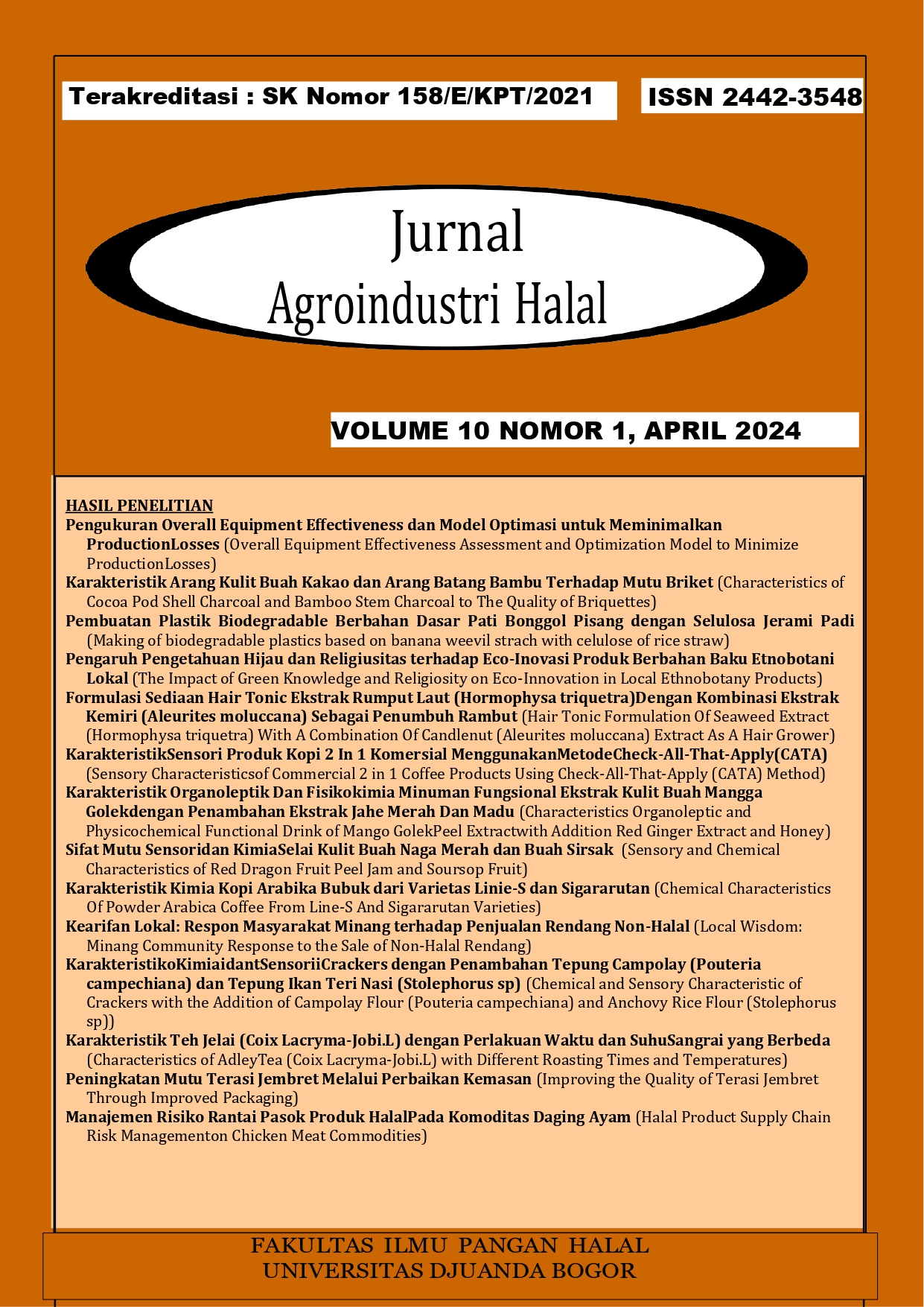Manajemen Risiko Rantai Pasok Produk Halal Pada Komoditas Daging Ayam
Main Article Content
Abstract
This study aims to analyze the supply chain management of halal products in the Yogyakarta Chicken Processing Region. The type of research used is a combination model/concurrent embedded design research. The method of House of Risk as the integration of Failure Models and Effect Analysis (FMEA) method was used in this research. The results of the research showed that the percentage of risk agents was used as the main factors including the risk agent A26, (Narrow Production Space) with a percentage of 12%, A27 with a percentage of 12% (Over Stock Capacity), A20 (negligence of the officer infollowing the SOP), A31 (Product damaged in shipping), A32 (Bad delivery vehicle), A34 (Company compensation to consumers for not meeting the consumer demand). Based on the results of calculations in the House of Risk model phase 2, the ranking of preventive actions that must be carried out first includes (PA 4) conducting training for workers, (PA 3) adding refrigeration machines, (PA 1) expanding production, (PA6) leasing transportation equipment, (PA2) managing production capacity, (PA7) having a clear agreement regarding the sale and purchase agreement.
Article Details

This work is licensed under a Creative Commons Attribution-ShareAlike 4.0 International License.
Authors who publish with Jurnal Agroindustri Halal agree to the following terms:
- Authors retain copyright and grant the journal right of first publication with the work simultaneously licensed under a Creative Commons Attribution 4.0 International License that allows others to share the work with an acknowledgement of the work's authorship and initial publication in Jurnal Agroindustri Halal.
- Authors are able to enter into separate, additional contractual arrangements for the non-exclusive distribution of the journal's published version of the work (e.g., post it to an institutional repository or publish it in a book), with an acknowledgement of its initial publication in Jurnal Agroindustri Halal.
- Authors are permitted and encouraged to post their work online (e.g., in institutional repositories or on their website) prior to and during the submission process, as it can lead to productive exchanges, as well as earlier and greater citation of published work
References
Anatan, L., & Ellitan, L. (2018). Supply Chain Management: Perencanaan, Proses, dan Kemitraan. Alfabeta.
Bahrudin, & Desa. (2011). Tracking and tracing technology for halal product integrity over the supply chain. International Conference on Electrical Engineering and Informatics, 1–7.
Gumilar, J., & Pratama, A. (2018). Produksi dan Karakteristik Gelatin Halal Berbahan Dasar Usus Ayam. Jurnal Teknologi Industri Pertanian, 28(1), 75–81.
Haryono, & Handayani, D. I. (2018). Pemodelan Sistem Traceability Halal Supply Chain dalam Menjaga Integritas Produk Makanan Halal Dengan Pendekatan Interpretive Structural Modeling (ISM). Prozima, 2(2), 74.
Kristianto, B. R., & Hariastuti, N. L. P. (2014). Aplikasi Model House of Risk (HOR) untuk Mitigasi Risiko pada Supply Chain Bahan Baku Kulit. Jurnal Ilmiah Teknik Industri, 13(2), 149–157. https://doi.org/https://doi.org/10.23917/jiti.v13i2.633
Ma’arifat, T. N., & Rahman, A. (2017). Penerapan Rantai Pasok Halal Pada Komoditas Daging Ayam di Kabupaten Ponorogo. Jurnal Pertanian Cemara, 14(1), 38–53. https://doi.org/10.24929/fp.v14i1.414
Ma’rifat, T. N., Purwanto, S., & Windarwati, S. (2017). Perception on Halal Ttraceability on Chicken Meat Supply Chain. Agroindustrial Technology Journal, 1(1), 33–41.
Magdalena, R., & Vannie. (2019). Analisis Risiko Supply Chain Dengan Model House Of Risk (Hor) Pada Pt Tatalogam Lestari. Jurnal Teknik Industri, 14(2), 53–62.
Matthew B. Miles, A. M. H. (2014). Qualitative Data Analysis (Third Edit). Arizona State University.
Mohamed, Y. H., Rahim, A. R. A., Ma’aram, A., & Ghazli, M. H. (2016). Halal Traceability in Enhancing Halal Integrity for Food Industry in Malaysia: A Review. International Research Journal of Engineering and Technology (IRJET), 3(3), 68–74.
Nurdin, M. S., & Rahman, Y. (2021). Sertifikasi Produk Halal oleh BPJPH DIY dengan Pendekatan Ekonomi Politik Perspektif Maqasid Syariah. Equilibrium: Jurnal Ekonomi Syariah, 9(1), 200. https://doi.org/10.21043/equilibrium.v9i1.9783
Omar, K. M., Mat, N. K. N., Imhemed, G. A., & Ali, F. M. A. (2016). The Direct Effects of Halal Product Actual Purchase Antecedents among the International Muslim Consumers. American Journal of Economics, Special Issue, 87–92. https://doi.org/10.5923/j.economics.20120001.20
Pujawan, I. N., & Geraldin, L. H. (2009). House Of Risk: A Model For Proactive Supply Chain Risk Management. Business Process Management Journal, 15(6), 953–967.
Sucipto, S., Wardan, R. I., Kama, M. A., & Setiyawan, D. T. (2020). Techno Economic Analysis of Chicken Slaughtering Equipment for Supporting Halal Assurance System Implementation. Jurnal Teknologi Industri Pertanian, 30(1), 72–81. https://doi.org/doi.org/10.24961/j.tek.ind.pert.2020.30.1.72
Sugiyono. (2016). Metode Penelitian Kuantitatif, Kualitatif dan Kombinasi (Mixed Methods). Alfabeta.
Tieman. (2011). The Application of Halal in Supply Chain Management: In-Depth Interviews. Journal of Islamic Marketing, 2, 186–195.
Zsidisin, & Ritchie. (2009). Supply Chain Risk Managemenet-Developments, Isuues and Challenges. International Series in Operation Research &Management Science, 1(24), 1–12.
Zulfakar, M. H., Anuar, M. M., & Thalib, M. S. A. (2012). Conceptual Framework On Halal Food Supply Chain Integrity Enhancement. Procedia-Social and Behavioral Sciences, 12(1), 58–67.
